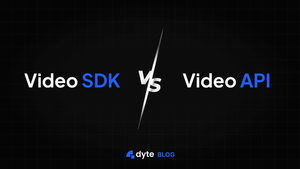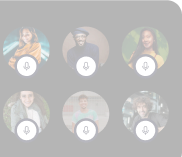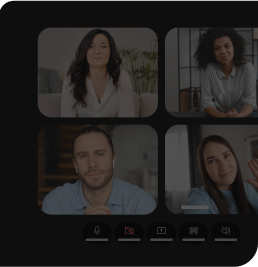SDKs and APIs are two different technologies used by developers. For starters, SDK or Software Development Kit acts as building blocks to build your application. Whereas API or Application Programming Interface enables you to communicate with other modules or third-party services.
Now, Video SDK is a pre-packaged development kit including APIs, libraries, and other components for developers to build their own interactive video experiences such as live-streaming, real-time video conferencing, etc. Video API are a subset of Video SDK in a sense. Video APIs let systems communicate with each other in order for the video interaction to happen smoothly.
We’ll dig deeper into what these are, how they are different, and when to use Video SDK vs Video API.
What is Video SDK?
A Video SDK, or Software Development Kit, is a set of software development tools that allows developers to build video-related applications or integrate video functionalities into existing applications. This could include features like live streaming, video conferencing, video recording, etc.
The SDK typically includes libraries, APIs (Application Programming Interfaces), documentation, and code samples to help developers understand how to use the tools. It provides a structured way to interact with a specific platform's video capabilities, saving developers the time and effort of building these functionalities from scratch.
For instance, Zoom's Video SDK allows developers to leverage Zoom's video technology within their own applications, enabling things like interactive video meetings or webinars without needing the mundane Zoom UI. However, Zoom's Video SDK has its own set of limitations when it comes to customizations, permission control, HLS streaming, etc.
Now, if you want to integrate Video Conferencing SDK into your product and are looking for Zoom Video SDK Alternatives, check out this honest comparison of Zoom vs Dyte Video SDK.
If you are done with Zoom's video conferencing and struggling with Zoom fatigue, you can check out Zoom alternatives.
Features of a good Video SDK
A good Video SDK should have the following features:
- High-Quality Video
- Cross-Platform Compatibility
- Low Latency
- Scalability
- Security
- Interactive Features
- Recording and Playback
- Bandwidth Management
- Easy integration
- Customization
What is Video API?
A Video API, or Application Programming Interface, is a set of rules and protocols that allows different software applications to communicate with each other. In the context of video, it's a way for developers to integrate video-related features into their applications without having to build the functionality from scratch.
Video APIs work by providing endpoints (URLs) that a developer's application can send requests to. The video platform's server then responds to these requests, providing the requested data or performing the requested action.
Popular examples of video APIs include Twilio's Programmable Video API, which provides tools for embedding real-time video and audio communication into apps. But Twilio Video APIs don't offer HLS and RTMP streaming, breakout rooms, or live transcription and have a cap on a maximum number of 50 participants in audio and video calls as compared to 200 with Dyte's Video APIs. Check out this how Twilio Video APIs compare with Dyte's Video APIs. And if you are looking for a Twilio video alternative, you know where to find us ;D
Features of a good Video API
A good Video API (Application programming interface) should have the following features:
- Adaptive Bitrate Streaming
- Direct Uploads and Pull-Based Inputs
- Video Analytics
- Content Delivery Networks (CDNs)
- Security Features
- Consistency
- Flexibility and Control
What is the difference between Video SDK vs Video API?
| Video SDK (Software Development Kit) | Video API (Application Programming Interface) | |
| What is it? | A set of software tools and programs that developers use to create applications for specific platforms. | A set of rules and protocols for building and interacting with software applications. |
| Functionality | Provides pre-built components and libraries for video functionality, which can be directly integrated into the application. | Provides endpoints for requesting video-related actions or data, allowing more flexibility in how the video functionality is implemented. |
| Ease of Use | Typically easier to use as they provide ready-to-use components and a more streamlined development experience. | Might require more knowledge and effort to use effectively, as the developer needs to handle the communication with the API's endpoints. |
| Flexibility | May offer less flexibility as the functionality is pre-defined by the SDK. | More flexible as it allows developers to define exactly what functionality they need from the API. |
| Examples | Twilio Video SDK, Agora Video SDK, Dyte Video SDK | Twilio Programmable Video API, Agora Video API, Dyte Video Conferencing APIs |
Please note that the choice between an SDK and an API will depend on the specific needs and constraints of your project.
When to use Video SDK vs Video API
The decision to use a Video SDK or a Video API depends on your specific needs, resources, and the complexity of your project.
When to use Video SDK?
Use Video SDK when you are looking for:
- Ease of Implementation: If you need to quickly integrate video functionality into your application without worrying too much about the details, an SDK with pre-built components can be easier and faster to implement.
- Specific Platform Compatibility: If you're developing for a specific platform (like Android, iOS, or Windows), an SDK designed for that platform will often provide the best performance and compatibility.
- Support and Maintenance: SDKs often come with extensive documentation and direct support from the provider, which can be helpful if you run into any issues.
When to use Video API?
Use Video API when your priority is:
- Customization: If you need a high level of customization for your video functionality, an API might be the better choice. APIs allow you to pick and choose exactly what features you need and how they should work.
- Integration with Other Services: APIs can often be more easily integrated with other services. For instance, you might use a video API in combination with other APIs to build a complex application with various functionalities.
- Scalability: If you're building a large-scale application that needs to handle a lot of video data, an API might be more suitable. APIs are designed to handle large amounts of requests and data and can often be scaled up or down as needed.
Remember, it's not always a choice between one or the other. In many cases, developers use both SDKs and APIs together to build their applications.
Conclusion
The primary difference between a Video SDK and a Video API is that a video SDK is a pre-built development kit including APIs, libraries, drivers, and network protocols that can be used to tailor your video app the way you want. Whereas Video APIs enable these protocols to communicate with each other in order for video interactions to function smoothly.
If you are looking to integrate Video SDK or APIs, you must look for platforms that offer secure, well-documented, reliable, and lightweight Video SDK and APIs.
Let us help you get started. If you’re curious about what Dyte is capable of, here are some resources to start off your research:
Interested? Let’s talk and figure out what Dyte can do to make the development of your video app smoother.
FAQs
Can I use both a Video SDK and a Video API in my application?
Yes, in many cases, developers use both SDKs and APIs together to build their applications. The SDK can provide a solid foundation and essential features, while the API can be used to add more specific or complex functionalities.
How do Video SDKs and Video APIs work together?
Video SDKs often use APIs under the hood to interact with video services. The SDK provides a user-friendly interface for the developer, while the API handles the communication with the video service.



